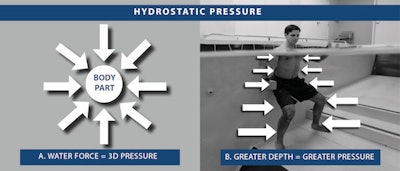
This sponsored content was provided by SwimEx. What is sponsored content?
Hydrotherapy is the ultimate training and recovery tool. It’s a low impact workout that yields high impact results with less joint stress, muscle fatigue, and injury. Athletes can work harder, recover faster, and stay in the game. It’s a rehabilitation tool that allows for conditioning during recovery with faster results. But why does it work?
The answer lies in three basic principles of water: hydrostatic pressure, buoyancy, and viscosity. Here’s a simple explanation of what they are and why they work.
1. HYDROSTATIC PRESSURE
Hydrostatic pressure is the weight of a fluid – in this case water – against an object. When an athlete gets in the water, hydrostatic pressure creates a uniform support system for all immersed body parts.
- The support is complete and surrounds the body from all sides.
- The deeper you go, the greater it supports.
 Hydrostatic Pressure explained
Hydrostatic Pressure explained
Benefits of hydrostatic support include reduced swelling, improved circulation, diminished soreness due to lactic acid reduction, less joint stress and less cardiovascular strain. Overall, it leads to faster treatment outcomes and successful workout results.
2. BUOYANCY
Buoyancy is the ability to float in water. The deeper you go, the less weight you have to bear. Based on buoyancy principles, an athlete immersed in water up to his or her neck bears 10% of their body weight. If the water is at chest level, they bear 25% of their weight, and if the water is at hip level, they bear 50% of their weight. Water’s zero-impact environment is ideal for getting in shape or recovering from an injury. The weightlessness it provides means an athlete can get an intense workout with less joint stress and pressure. Stretching out tight muscles is much easier because water’s buoyancy helps improve range of motion. In addition, athletes can rehabilitate without further straining injuries. They can begin therapy protocols much sooner than on land and condition during treatments. This means they stay in shape during recovery and are ready to play as soon as they heal.
3. VISCOSITY
Viscosity is a fluid’s resistance against an object. In this case, water. The resistance or drag of water, combined with hydrostatic pressure and buoyancy, creates the ideal environment for training and therapy. Exercises in water provide up to 15 times more resistance that the same exercises on land. When a water current is added (available in most hydrotherapy pools) with varied speeds, this can ramp up the intensity of workouts or create treatment protocols that help athletes successfully progress through each stage of recovery. Aquatic fitness and therapy provides an ideal environment to give athletes the confidence and support to perform proper mechanics with less pain and better results.
If you’re interested in learning more about how SwimEx hydrotherapy can help your athletes train harder and recover faster, visit swimex.com or email [email protected].
- Related: What are other benefits of hydrostatic pressure? Click here to learn about its ability to work as a compression device, increase breathing capacity, and more.
- Related: How do the Chicago Cubs use hydrotherapy in their training? Download their training guide here.





































